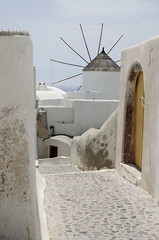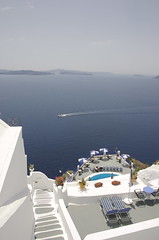Σαντορίνη
Something to know about me: I don’t travel well. I get nervous, my sense of direction is abysmal, I’m picky about food. I just don’t have the wanderlust.
None of which is to say I don’t enjoy seeing new places — I do — more that I need to build myself up to it, and then survive on adrenaline when I’m there. I haven’t travelled much outside the UK; a few European city-breaks, and one short visit to Kenya when my wife was doing her medical school elective there. That was more than five years ago, so I may not be remembering it clearly but I think our most recent trip, to Santorini, has trumped Kenya on unfamiliarity. Maybe it’s because it’s still part of Europe (Greece), so psychologically the differences were more visible.
Getting there is a bit of a nuisance. The way the connections worked out coming from Belfast we had six or seven hours sitting in Athens overnight before the 05.45 flight to Santorini, getting us on the ground on the island before 06.30. When we collected the hire car and drove from the airport it was still soon enough after dawn that we saw the rising sun catching the mountains and east-facing cliffs, with the small whitewashed buildings and blue-domed churches scattered everywhere. The sight was stunning, but for this Belfast boy it felt completely alien.
Santorini is formed from the edge of a volcanic crater peeking out from the sea. (The volcano is still active, so I guess there was a chance the whole place would explode while we were there. I’m pleased to report that it didn’t.) Across the road from our hotel we could stand and see the various islands around the caldera. Two islands in the middle are where the volcano still vents. There’s something satisfying about being able to stand and look at the islands and connect them easily with the map on the wall of the hotel dining room.
Our Lonely Planet guidebook advises that when you hire a car on Santorini (which is refreshingly affordable) you should approach the roads with patience and caution. Not only are they narrow and winding, with markings faded as a rule to near-invisibility, but each spectacular view seems placed perfectly to distract from an upcoming bend or crossroads (I never did figure out who has right of way at any given crossroads). Add that the fact that I’ve never had to drive on the right-hand side of the road before and I found my adrenaline!
Fira, the capital, hangs off the cliff inside the caldera, as does the village of Oia on the northern horn of the island. Where Fira has a fast, crowded atmosphere, Oia is much more relaxed — even when we were there and it was mobbed with cruisers from the ships resting in the caldera. It’s very easy to pass a day (or more) exploring either place, where the whitewashed alleyways are lined with shops from expensive jewelers to three shops in a row selling the same selection of baseball caps, shards of rock dancing donkeys on a string. The alleys seem to catch and hold the sun and the heat, and I was glad that almost everywhere had an air-conditioner over the door.
One of the owners of our hotel explained to me that the blue domes are all churches, although not all churches have the distinctive blue-domed roof. She told us that each town or village has a main church that gets used regularly, then many smaller ones that will only get used for special occasions, perhaps for a given family’s name-day celebrations. As she told us, “In Santorini there are more churches than houses, more wine than water and more donkeys than people. Maybe not the donkeys any more, but the other two… yes.”
Highlights of our trip included dinner at Ambrosia & Nectar in Oia, reliably beautiful sunsets over the caldera, another spectacular view around every bend in the road, Greek hospitality, no more than four drops of rain and the compliant way my hayfever switched off for a week!
I’d love to return to Santorini, either for a holiday or specifically to photograph all the churches — that would be a very enjoyable project indeed.

